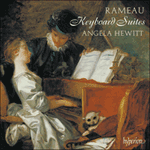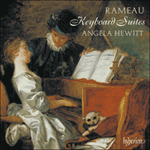
Welcome to Hyperion Records, a British classical label devoted to presenting high-quality recordings of music of all styles and from all periods from the twelfth century to the twenty-first.
Hyperion offers both CDs, and downloads in a number of formats. The site is also available in several languages.
Please use the dropdown buttons to set your preferred options, or use the checkbox to accept the defaults.

| Angela Hewitt (piano)» More |

Les triolets takes its name from a genre of French poetry which by Rameau’s day had already become quite archaic. There is no discernible connection between this piece and the poetic form, but I have always imagined it to depict the discovery of old love letters in the attic of one’s grandparents, so sweet is the quality of nostalgia—and so fleeting, for in the closing bars of the petite reprise we hear the past crumbling like old paper in our hands. Les sauvages represents impressions of two Huron Indians sent from French Canada in the 1720s who performed at the Théâtre italien in Paris to a large crowd of curious observers. The unwieldy contour of the principal theme, based on bizarre leaps, transmits the quality of naïveté ascribed by eighteenth-century Europeans to anyone they considered to be ‘noble savages’. Rameau goes from the exotic to the esoteric in the following piece, L’enharmonique, which derives its name, as Rameau explains in the preface to the collection, from the enharmonic spelling of certain notes and chords which form the basis for striking chromatic modulations. Always certain to justify his musical decisions, Rameau argues that ‘the harmony which creates this effect has by no means been thrown in haphazardly; it is based on logic and has the sanction of nature herself’—a clear reference to the use of a circular temperament of some kind. The concluding L’egiptienne (not L’Égyptienne as it appears in some modern editions) portrays the wild mystery of a gypsy girl. Crossed-hand imitative gestures with descending arpeggios create a cascade of sound at once powerful and capricious. She is the darker, sultrier, and much more fun counterpart to Debussy’s Girl with the flaxen hair.
from notes by Mahan Esfahani © 2014
Les triolets tirent leur nom d’un genre de poésie française qui, à l’époque de Rameau, était déjà devenu très archaïque. On ne discerne aucun lien entre cette pièce et la forme poétique, mais j’ai toujours imaginé qu’elle dépeignait la découverte de vieilles lettres d’amour dans le grenier des grands-parents, tant l’impression de nostalgie est douce—et fugace, car dans les dernières mesures de la petite reprise on entend le passé s’effriter comme du vieux papier entre nos mains. Les sauvages représentent les impressions de deux Indiens hurons envoyés du Canada français dans les années 1720, qui jouèrent au Théâtre italien à Paris devant une grande foule d’observateurs curieux. Le contour compliqué du thème principal, basé sur des sauts étranges, transmet une certaine naïveté attribuée par les Européens du XVIIIe siècle à tous ceux qu’ils considéraient comme de «nobles sauvages». Rameau passe de l’exotique à l’ésotérique dans la pièce suivante, L’enharmonique, qui tire son nom, ainsi que l’explique Rameau dans la préface du recueil, de l’écriture enharmonique de certaines notes et accords formant la base de modulations chromatiques frappantes. Toujours soucieux de justifier ses décisions musicales, Rameau soutient que «l’harmonie qui cause cet effet n’est point jettée au hazard; elle est fondée en raisons, et autorisée par la nature même»—référence claire à l’utilisation d’un tempérament circulaire d’un certain genre. L’egiptienne (et non L’Égyptienne comme elle apparaît dans certaines éditions modernes) finale décrit le mystère sauvage d’une gitane. Des gestes imitatifs de mains croisées avec des arpèges descendants créent une cascade sonore puissante et extravagante. C’est l’homologue plus sombre, plus sensuel et beaucoup plus drôle de La fille aux cheveux de lin de Debussy.
extrait des notes rédigées par Mahan Esfahani © 2014
Français: Marie-Stella Pâris
Les triolets ist nach einer französischen Gedichtform benannt, die zu Rameaus Zeit bereits etwas antiquiert war. Es gibt keine erkennbare Verbindung zwischen diesem Stück und der Gedichtform, aber in meiner Vorstellung schildert es die Entdeckung alter Liebesbriefe auf dem großelterlichen Dachboden, so liebenswert ist die Nostalgie—und so flüchtig, denn in den Schlußtakten der petite reprise hört man die Vergangenheit zerbröseln wie altes Papier zwischen den Fingern. Les sauvages bringt Impressionen von zwei Indianern (Huronen) aus Französisch-Kanada, die in den 1720er Jahren am Théâtre italien in Paris vor einer großen Menge neugieriger Zuschauer auftraten. Die schwerfällige Kontur des auf bizarren Sprüngen beruhenden Hauptthemas vermittelt die naïveté, die die Europäer des 18. Jahrhunderts jedem zugeschrieben haben, den sie als „edlen Wilden“ ansahen. Rameau geht im folgenden Stück, L’enharmonique, vom Exotischen zum Esoterischen über; der Titel ist, wie Rameau im Vorwort zu dem Sammelband erläutert, von der enharmonischen Schreibweise bestimmter Töne und Akkorde abgeleitet, die den eindringlichen chromatischen Modulationen zugrundeliegen. Immer mit der Absicht, seine musikalischen Entscheidungen zu begründen, erklärt Rameau: „die Harmonie, die diesen Eindruck hervorruft, ist keineswegs eine zufällige; sie beruht auf Vernunftgründen und wird von der Natur selbst bestätigt“—ein deutlicher Hinweis auf die Verwendung einer Art „wohltemperierter Stimmung“. Das abschließende L’egiptienne (nicht L’Égyptienne, wie man es in einigen modernen Ausgaben findet) schildert eine wilde, rätselhafte Zigeunerin. Überkreuz gespielte Imitationen mit absteigenden Arpeggien erzeugen eine so kraftvolle wie kapriziöse Klangkaskade. Es ist ein dunkleres, feurigeres und viel witzigeres Pendant zu Debussys Prélude La fille aux cheveux de lin (Das Mädchen mit dem flachsfarbenen Haar).
aus dem Begleittext von Mahan Esfahani © 2014
Deutsch: Christiane Frobenius
 Rameau: Keyboard Suites Rameau: Keyboard SuitesJean-Philippe Rameau started his career in an unusual manner, a provincial organist who rarely served out his contract (and on one occasion deliberately played sufficiently badly to ensure his dismissal). By 1745, however, he had risen to be ‘Comp ...» More |
 Rameau: Keyboard Suites Rameau: Keyboard Suites |

